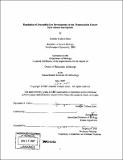Regulation of Drosophila eye development by the transcription factors : eyes absent and Spenito
Author(s)
Jemc, Jennifer Colleen
DownloadFull printable version (27.72Mb)
Alternative title
EYA and NITO
Other Contributors
Massachusetts Institute of Technology. Dept. of Biology.
Advisor
Ilaria Rebay.
Terms of use
Metadata
Show full item recordAbstract
During development of an adult organism from a fertilized embryo, signaling pathways are deployed reiteratively to regulate a variety of cellular processes, including cell proliferation, specification, differentiation, migration, survival and death. These signaling pathways do not act independently, but rather are integrated to yield desired developmental outcomes. While there are a variety of mechanisms by which signaling pathways are integrated, our work has focused on signal integration at the level of transcriptional control. Signaling pathways have been demonstrated to converge at the level of transcription, either by regulating activity of a common transcription factor and affecting its transcriptional output, or by regulating activity of distinct transcription factors, which target a common set of genes. In order to understand how signaling pathways are integrated to affect developmental outcomes, it is not only necessary to investigate the regulation of these transcription factors during development, but also it is necessary to identify their downstream transcriptional targets. In this thesis we have focused on the roles of two downstream transcriptional effectors, Eyes absent (EYA) and Spenito (NITO), in Drosophila eye development. (cont.) EYA is a member of the retinal determination gene network (RDGN), a network of transcription factors and cofactors that when mutated result in defects in eye development, and when overexpressed can induce ectopic eye development. EYA functions as a part of a bipartite transcriptional complex, with EYA providing the transactivation function for the complex, and its cofactor Sine oculis (SO), providing the DNA-binding function. In addition to acting as a transcription cofactor, EYA also functions as a protein phosphatase, presenting a unique juxtaposition of functions and raising the question, how are these functions related? In order to examine how transcriptional activity is affected by mutating EYA phosphatase activity, we needed to identify additional transcriptional targets, given that only one target had been identified at the time these experiments began. Using microarray analysis, we compared expression profiles of wildtype tissue to those of tissue overexpressing a wildtype eya transgene. In parallel, we overexpressed a phosphatase mutant eya transgene, which allowed us to examine the overall effects of reducing phosphatase activity on transcriptional output. (cont.) We identified 577 genes with altered expression upon overexpression of wildtype or mutant eya and confirmed 6 genes as direct targets of EYA transcriptional regulation, including string, a cell cycle regulatory gene. Stg is a particularly intriguing target, given previously characterized proliferation defects observed in tissue misexpressing eya and so. In addition, our array results suggest that mutating EYA phosphatase activity does not globally impair EYA's transcriptional output, suggesting that these functions are somewhat independent. Further analysis of transcriptional target expression and identification of targets of EYA phosphatase activity will be necessary to understand how these two functions are integrated during development. In addition, we have examined the role of SPOC family proteins, which function as effectors of Notch, Wingless and Epidermal Growth Factor Receptor (EGFR) signaling, in Drosophila eye development. Studies of these proteins in cultured cells have demonstrated their ability to function as transcriptional coregulators. In the work presented here, we have investigated the role of the small SPOC protein, Spenito (NITO), during Drosophila eye development and analyzed its relationship to a large SPOC protein, Split ends (SPEN), which is predicted to have redundant function. (cont.) First, we characterized the eye phenotypes arising from overexpression of nito. Overexpression of nito perturbs eye development and in contrast to spen, which has been shown to act as a positive effector of EGFR signaling, appears to be a negative effector of EGFR signaling during eye development. Further genetic analysis of the relationship between spen and nito in the eye suggests they function antagonistically, possibly by targeting a common set of genes for transcriptional regulation. Further analysis of SPOC family mutants and study of the functions of these proteins at a molecular level will be necessary to understand the relationship of small and large SPOC proteins and the roles of the proteins in development and disease.
Description
Thesis (Ph. D.)--Massachusetts Institute of Technology, Dept. of Biology, 2007. Includes bibliographical references.
Date issued
2007Department
Massachusetts Institute of Technology. Department of BiologyPublisher
Massachusetts Institute of Technology
Keywords
Biology.